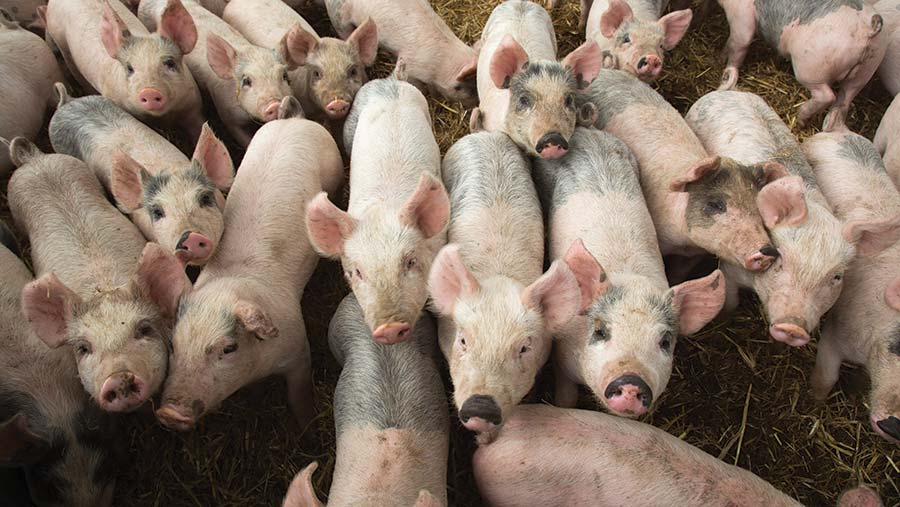5 ways to reduce stress when weaning pigs
 © Tim Scrivener
© Tim Scrivener Weaning is a huge change for young pigs at a vulnerable time in terms of immunity, so making the process as smooth as possible can have production benefits throughout the animal’s lifetime.
It is vital to ensure pigs are as robust as possible at weaning, and the correct age and weight. Pigs should be no younger than 28 days, according to EU law, unless a derogation is received to wean at 21 days.
Stressors at weaning time can have negative effects including:
- Reduced feed intake
- Reduced growth
- Poor feed efficiency
- Health consequences
- Increased production costs.
Good growth of the pig in the weaning period increases weight gain up until slaughter.
Vet Christina Huelsmann-Diamond of Farmvet Integrated Livestock Services explains some of the areas which can be addressed to minimise potential stressors.
1. Environment
As a priority, all feeders, equipment and tools need to be cleaned and disinfected and the drinking system needs to be sanitised between batches.
The five basic principles of cleaning and disinfecting are:
- Removing organic matter – mucking out (dung can inactivate disinfectant) and removing any moveable items
- Soaking – with cold water and detergent (should also be degreaser) under low pressure for at least an hour
- Washing – preferably with hot water, under high pressure, then rinsing
- Disinfecting – should be a Defra-approved product at the correct dilution, applied under low pressure
- Drying – key to allow the disinfectant to work.
2. Temperature
Temperature is very important. It is difficult to set hard-and-fast rules because requirements depend on animal health and weight, feed intake and, especially, housing. However, rough targets would be:
- 28-30C at weaning for a couple of days until the pigs are feeding well
- Slowly reduce to 27C by day five, but not by more than 1-1.5C a week and not more than 1C a day
- Reduce to 23C by the time animals are 20kg
In a straw-based system with a kennel area or feeding area, the starting temperature can be reduced to 25C, dropping to 23C at 20kg.
Higher temperatures are required on slatted floors, in hospital/isolation pens, when a draught is present, or when pigs are unwell.
Observing the pigs can tell you a lot about their thermal comfort. Hot pigs may lie far apart, pant, eat less and try to cool off by lying in wetter areas or dung. Cold pigs will be cold to the touch, hairy, grow less quickly and succumb to disease more easily.
3. Feed transition
Of all the life stages, weaners have the best feed conversion ability, which is why they are fed the best diets to maximise that conversion for their growth.
Key considerations when it comes to feeding include:
- Feed availability and space for piglets
- Transition between diets – from milk to starter to link diets
- Targeting the right feed and water intakes
- Providing enough water in the right way
- Acidifying water
- Assessing feed conversion rates
All of this is covered in our guide to feed and water requirements for weaners.
4. Grouping appropriately
Weaning into litter groups will be the least stressful method. However, it is often not possible if space is limited. Therefore, weaning by size is the next best option to reduce competition at feeders and drinkers and allow the hierarchy to be established more quickly.
Ideally, this would be into three groups – small, medium and large pigs – although this can be reduced to two groups if pens are limited. All pigs should be approximately the same age.
Splitting by sex alone is less effective but can be an additional factor in grouping to reduce riding later on.
Stocking density requirements |
|
|
Average liveweight range (kg) |
Unobstructed floor space (sq m/pig) |
|
Up to 10 |
0.15 |
|
10-20 |
0.2 |
|
20-30 |
0.3 |
|
30-50 |
0.4 |
|
50-85 |
0.55 |
|
85-110 |
0.65 |
|
Over 110 |
1 |
|
Source: Welfare Code |
|
5. Health monitoring
Ill health is the biggest limiting factor to feed intake and weaned pig performance. Any disease challenge triggers an immune response, whether the animal gets ill or not, and the immune response reduces performance.
Monitoring for signs of ill-health is key so that corrective action can be taken rapidly if necessary. Routine treatments, such as vaccination, should be done on veterinary advice and kept up to date.
Signs of illness to watch for are:
- Discharge around the snout and eyes
- Change in breathing rate, or “heaving”
- Coughing or sneezing
- Lameness
- Scours – both diarrhoea and wet/red rear ends
- Morbid behaviours
- Changes to eating and drinking patterns or amount
- White or hairy skin.
Smaller weaner management
Smaller animals need preferential treatment as they produce less heat, eat less food and are more prone to disease as a result. If grouping is not as good as it could be, they could then be subject to bullying which further affects their intakes, heat and health in a vicious cycle.
Ways to combat this include:
- Separate penning or using a pen within a pen
- More bedding or higher temperature
- Feeding creep and/or gruel for longer before moving to link diet
- Providing acidified water
- Placing feeders and drinkers closer to the lying area and lowering heights where appropriate
- Stirring the pigs often, in as calm a way as possible, to encourage intakes
- Assessing health and then medicating, if appropriate.
